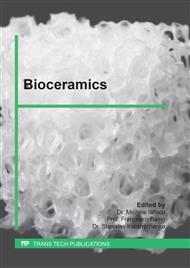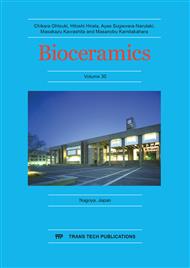[1]
H. Petite, V. Viateau, W. Bensaid, A. Meunier, C. de Pollak, M. Bourguignon, K. Oudina, L. Sedel, G. Guillemin, Tissue-engineered bone regeneration, Nature 18 (2000) 959-963.
DOI: 10.1038/79449
Google Scholar
[2]
D. Tang, R. S. Tare, L. Y. Yang, D. F. Williams, K. L. Ou, R. O. C. Oreffo, Biofabrication of bone tissue: Approaches, challenges and translation for bone regeneration, Biomaterials 83 (2016) 363-382.
DOI: 10.1016/j.biomaterials.2016.01.024
Google Scholar
[3]
M. D. Hoffman, C. Xie, X. Zhang, D. S. Benoit, The effect of mesenchymal stem cells delivered via hydrogel-based tissue engineered periosteum on bone allograft healing, Biomaterials 34 (2013) 8887-8889.
DOI: 10.1016/j.biomaterials.2013.08.005
Google Scholar
[4]
S. Wu, X. Liu, K. W. K. Yeung, C. Liu, X. Yang, Biomimetic porous scaffolds for bone tissue engineering, Mater. Sci. Eng. R Rep. 80 (2014) 1-36.
Google Scholar
[5]
R. Murugan, S. Ramakrishna, Bioresorbable composite bone paste using polysaccharide based nano hydroxyapatite, Biomaterials 25 (2004) 3829-3835.
DOI: 10.1016/j.biomaterials.2003.10.016
Google Scholar
[6]
M. Kikuchi, S. Itoh, S. Ichinose, J. Tanaka, Self-organization mechanism in a bone-like hydroxyapatite/collagen nanocomposite synthesized in vitro and its biological reaction in vitro, Biomaterials 22 (2001) 1705-1711.
DOI: 10.1016/s0142-9612(00)00305-7
Google Scholar
[7]
H. W. Kim, H. E. Kim, V. Salih, Stimulation of osteoblast responses to biomimetic nanocomposites of gelatin-hydroxyapatite for tissue engineering scaffolds, Biomaterials 26 (2005) 5221-5230.
DOI: 10.1016/j.biomaterials.2005.01.047
Google Scholar
[8]
W. Jie, L. Yubao, Tissue engineering scaffold material of nano-apatite crystals and polyamide composite, Eur. Polym. J. 40 (2004) 509-515.
DOI: 10.1016/j.eurpolymj.2003.10.028
Google Scholar
[9]
H. Wang, Y. Li, Y. Zuo, J. Li, S. Ma, L. Cheng, Biocompatibility and osteogenesis of biomimetic nano-hydroxyapatite/polyamide composite scaffolds for bone tissue engineering, Biomaterials 28 (2007) 3338-3348.
DOI: 10.1016/j.biomaterials.2007.04.014
Google Scholar
[10]
G. Wei, P. X. Ma, Structure and properties of nano-hydroxyapatite/ polymer composite scaffolds for bone tissue engineering, Biomaterials 25 (2004) 4749-4757.
DOI: 10.1016/j.biomaterials.2003.12.005
Google Scholar
[11]
S. S. Kim, M. S. Park, O. Jeon, C. Y. Choi, B. S. Kim, Poly(lactide-co-glycolide)/hydroxyapatite scaffolds for bone tissue engineering, Biomaterials 27 (2006) 1399-1409.
DOI: 10.1016/j.biomaterials.2005.08.016
Google Scholar
[12]
D. R. Biswal, R. P. Singh, Flocculation studies based on water-soluble polymers of grafted carboxymethyl cellulose and polyacrylamide, J. Appl. Polym. Sci. 102 (2006) 1000-1007.
DOI: 10.1002/app.24016
Google Scholar
[13]
C. H. N. Sieger, A. G. M. Kroon, J. G. Batelaan, C. G. V. Ginkel, Biodegradation of carboxymethyl celluloses by Agrobacterium CM-1, Carbohydr. Polym. 27 (1995) 137-143.
DOI: 10.1016/0144-8617(95)00039-a
Google Scholar
[14]
E. K. Just, T. G. Majewicz, Encyclopedia of Polymer Science and Technology, second ed., Herman F. Mark, New York, 1989, p.226.
Google Scholar
[15]
D. L. He, L. L. Bao, Y. M. Long, W. Z. Wei, S. Z. Yao, A new study of the enzymatic hydrolysis of carboxymethyl cellulose with a bulk acoustic wave sensor, Talanta 50 (2000) 1267-1273.
DOI: 10.1016/s0039-9140(99)00229-5
Google Scholar
[16]
F. Nagata, T. Miyajima, K. Kato, Preparation of phylloquinone-loaded poly(lactic acid)/hydroxyapatite core-shell particles and their drug release behavior, Adv. Powder Technol. 27 (2016) 903-907.
DOI: 10.1016/j.apt.2016.02.007
Google Scholar



